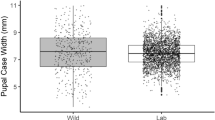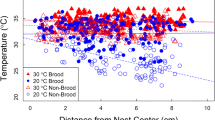Abstract
The eusocial bumblebees exhibit pronounced size variation among workers of the same colony. Differently sized workers engage in different tasks (alloethism); large individuals are found to have a higher probability to leave the colony and search for food, whereas small workers tend to stay inside the nest and attend to nest duties. We investigated the effect of size variation on morphology and physiology of the peripheral olfactory system and the behavioral response thresholds to odors in workers of Bombus terrestris. Number and density of olfactory sensilla on the antennae correlate significantly with worker size. Consistent with these morphological changes, we found that antennal sensitivity to odors increases with body size. Antennae of large individuals show higher electroantennogram responses to a given odor concentration than those of smaller nestmates. This finding indicates that large antennae exhibit an increased capability to catch odor molecules and thus are more sensitive to odors than small antennae. We confirmed this prediction in a dual choice behavioral experiment showing that large workers indeed are able to respond correctly to much lower odor concentrations than small workers. Learning performance in these experiments did not differ between small and large bumblebees. Our results clearly show that, in the social bumblebees, variation in olfactory sensilla number due to size differences among workers strongly affects individual odor sensitivity. We speculate that superior odor sensitivity of large workers has favored size-related division of labor in bumblebee colonies.



Similar content being viewed by others
References
Agren L, Hallberg E (1996) Flagellar sensilla of bumble bee males (Hymenoptera, Apidae, Bombus). Apidologie 27:433–444
Beshers SN, Fewell JH (2001) Models of division of labor in social insects. Annu Rev Entomol 46:413–440
Beshers SN, Robinson GE, Mittenthal JE (1999) Response thresholds and division of labor in insect colonies. In: Detrain C, Deneubourg JL, Pasteels JM, (eds) Information processing in social insects. Birkhäuser, Basel, pp 115–139
Brian AD (1952) Division of labor and foraging in Bombus agrorum Fabricius. J Anim Ecol 21:223–240
Bonabeau E, Theraulaz G (1999) Role and variability of response thresholds in the regulation of division of labor in insect colonies. In: Detrain C, Deneubourg JL, Pasteels JM, (eds) Information processing in social insects. Birkhäuser, Basel, pp 141–163
Brockmann A, Brückner D, Crewe RM (1998) The EAG response spectra of workers and drones to queen honeybee mandibular gland components: the evolution of a social signal. Naturwissenschaften 85:283–285
Bullock SH (1999) Relationships among body size, wing size and mass in bees from a tropical dry forest in México. J Kans Entomol Soc 72:426–439
Chapman RF (1982) Chemoreception: the significance of receptor numbers. In: Berridge MJ, Treherne JE, Wigglesworth VB (eds) Advances in insect physiology, vol. 16. Academic Press, New York, pp 247–356
Chapman RF (1998) The insects. Cambridge University Press, Cambridge
Chittka L, Thomson J, Waser NM (1999) Flower constancy, insect psychology, and plant evolution. Naturwissenschaften 8:361–377
Cumber RA (1949) The biology of humble-bees, with special reference to the production of the worker caste. Trans R Entomol Soc Lond 100:1–45
Dekker T, Ibba I, Siju KP, Stensmeyr MC, Hansson BS (2006) Olfactory shifts parallel superspecialism for toxic fruit in Drosophila melanogaster sibling, D. sechellia. Curr Biol 16:101–109
Esslen J, Kaissling KE (1976) Zahl und Verteiling antennaler Sensillen bei der Honigbiene (Apis mellifera L.). Zoomorphol 83:227–251
Farris SM, Roberts NS (2005) Coevolution of generalists feeding ecologies and gyrencephalic mushroom bodies in insects. Proc Natl Acad Sci USA 102:17394–17399
Fonta C, Masson C (1985) Organisation neuroanatomique de la voie afférente antennaire chez les Bourdons mâles et femelles (Bombus sp.). C R Acad Sci Paris 3:437–442
Garófalo C (1978) Bionomics of Bombus (fervidobombus) morio: 2. body size and length of life of workers. J Apic Res 17:130–136
Goulson D, Peat J, Stout JC, Tucker J, Darvill B, Derwent LC, Hughes WOH (2002) Can alloethism in workers of the bumblebee Bombus terrestris be explained in terms of foraging efficiency? Anim Behav 64:123–130
Heinrich B (1979) Bumblebee economics. Havard University Press, Cambridge
Heisenberg M (2003) Mushroom body memoir: from maps to models. Nat Rev Neurosci 4:266–275
Hildebrand JG, Shepherd GM (1997) Mechanisms of olfactory discrimination: converging evidence for common principles across phyla. Annu Rev Neurosci 20:595–631
Kaissling K-E (1995) Single unit and electroantennogram recordings in insect olfactory organs. In: Spielman AI, Brand JG (eds) Experimental cell biology of taste and olfaction. CRC Press, Boca Raton, pp 361–377
Kaissling K-E, Thorson J (1980) Insect olfactory sensilla: structural, chemical and electrical aspects of the functional organization. In: Sattelle DB, Hall LM, Hildebrand JG (eds) Receptors for neurotransmitters, hormones and pheromones in insects. Elsevier, Amsterdam, pp 261–282
Mares S, Ash L, Gronenberg W (2005) Brain allometry in bumblebee and honey bee workers. Brain Behav Evol 66:50–61
Michener CD (1974) The social behavior of the bees. Harvard University Press, Cambridge
Nishino C, Kuwabara K (1983) Threshold dose values for sex pheromones of the American cockroach in electroantennogram and behavioural responses. Comp Biochem Physiol 74:909–914
Ochieng SA, Hansson BS (1999) Responses of olfactory receptor neurons to behaviourally important odours in gregarious and solitary desert locust, Schistocerca gregaria. Physiol Entomol 24:28–36
Pereboom JJM, Velthuis HHM, Duchateau MJ, et al. (2003) The organisation of larval feeding in bumblebees (Hymenoptera, Apidae) and its significance to caste differentiation. Insectes Soc 50:127–133
Plowright RC, Jay SC (1968) Caste differentiation in bumblebees (Bombus latr.: Hym.) I. The determination of female size. Insectes Soc 2:171–192
Rice WR (1989) Analyzing tables of statistical tests. Evolution 43:223–225
Rospars JP (1988) Structure and development of the insect antennodeutocerebral system. Int J Insect Morphol Embryol 17:243–294
Schneider D (1957) Eletrophysiologische Untersuchungen von Chemo- und Mechanorezeptoren der Antenne des Seidenspinners Bombyx mori. Z Vergl Physiol 40:8–41
Spaethe J, Chittka L (2003) Interindividual variation of eye optics and single object resolution in bumblebees. J Exp Biol 206:3447–3453
Spaethe J, Weidenmüller A (2002) Size variation and foraging rate in bumblebees (Bombus terrestris). Insectes Soc 49:142–146
Van der Gen A (1972) Corps olfactifs a l’odeau al jasmin. Parfum Cosmet Savon 2:356–370
Vander Meer RK, Breed MD, Espelie KE, Winston ML (1998) Pheromone communication in social insects. Westview Press, Oxford
Vareschi E (1971) Duftunterscheidung bei der Honigbiene - Einzelzell-Ableitungen und Verhaltensreaktionen. Z Vergl Physiol 75:142–173
White PR (1991) The electroantennogram response: effects of varying sensillum numbers and recording electrode position in a clubbed antenna. J Insect Physiol 37:145–152
Acknowledgment
We thank R. F. Chapman, J. G. Hildebrand, and J. Schachtner for their valuable comments on an earlier version of the manuscript and C. Lutz and S. Beshers for comments on the present version. J.S. and A.B. were supported by the German Research Foundation DFG (SFB554 and Graduiertenkolleg 200). The experiments in this study comply with the current laws of Germany.
Author information
Authors and Affiliations
Corresponding author
Additional information
Spaethe and Brockmann both contributed equally to the manuscript.
Rights and permissions
About this article
Cite this article
Spaethe, J., Brockmann, A., Halbig, C. et al. Size determines antennal sensitivity and behavioral threshold to odors in bumblebee workers. Naturwissenschaften 94, 733–739 (2007). https://doi.org/10.1007/s00114-007-0251-1
Received:
Revised:
Accepted:
Published:
Issue Date:
DOI: https://doi.org/10.1007/s00114-007-0251-1




